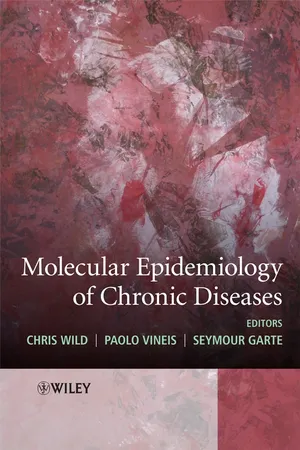
- English
- ePUB (mobile friendly)
- Available on iOS & Android
Molecular Epidemiology of Chronic Diseases
About this book
"This text provides an accessible and useful handbook for the epidemiologist who wants to survey the field, to become better informed, to look at recent developments and get some background on these or simply to appreciate further the relatively rapid changes in informatic and analytical technologies which increasingly will serve and underpin future epidemiological studies. One of the strengths in this book is the extensive array of practical illustrative examples, and it would also in my opinion have useful potential as a teaching text." –American Journal of Human Biology, March 2009
With the sequencing of the human genome and the mapping of millions of single nucleotide polymorphisms, epidemiology has moved into the molecular domain. Scientists can now use molecular markers to track disease-associated genes in populations, enabling them to study complex chronic diseases that might result from the weak interactions of many genes with the environment. Use of these laboratory generated biomarker data and an understanding of disease mechanisms are increasingly important in elucidating disease aetiology.
Molecular Epidemiology of Disease crosses the disciplinary boundaries between laboratory scientists, epidemiologists, clinical researchers and biostatisticians and is accessible to all these relevant research communities in focusing on practical issues of application, rather than reviews of current areas of research.
- Covers categories of biomarkers of exposure, susceptibility and disease
- Includes chapters on novel technologies: genomics, transcriptomics, proteomics and metabonomics, which are increasingly finding application in population studies
- Emphasizes new statistical and bioinformatics approaches necessitated by the large data sets generated using these new methodologies
- Demonstrates the potential applications of laboratory techniques in tackling epidemiological problems while considering their limitations, including the sources of uncertainty and inaccuracy
- Discusses issues such as reliability (compared to traditional epidemiological methods) and the timing of exposure
- Explores practical elements of conducting population studies, including biological repositories and ethics
Molecular Epidemiology of Disease provides an easy-to-use, clearly presented handbook that allows epidemiologists to understand the specifics of research involving biomarkers, and laboratory scientists to understand the main issues of epidemiological study design and analysis. It also provides a useful tool for courses on molecular epidemiology, using many examples from population studies to illustrate key concepts and principles.
Frequently asked questions
- Essential is ideal for learners and professionals who enjoy exploring a wide range of subjects. Access the Essential Library with 800,000+ trusted titles and best-sellers across business, personal growth, and the humanities. Includes unlimited reading time and Standard Read Aloud voice.
- Complete: Perfect for advanced learners and researchers needing full, unrestricted access. Unlock 1.4M+ books across hundreds of subjects, including academic and specialized titles. The Complete Plan also includes advanced features like Premium Read Aloud and Research Assistant.
Please note we cannot support devices running on iOS 13 and Android 7 or earlier. Learn more about using the app.
Information
| Marker linked to exposure or disease | Exposure | Reference |
| Exposure/biologically effective dose | ||
| DNA adducts | PAHs, aromatic compounds | Tang et al. 2001 |
| AFB1 | Ross et al. 1992 | |
| Albumin adducts | AFB1 | Wang et al. 1996 Gong et al. 2002 |
| Haemoglobin adducts | Acrylamide Styrene 1,3-Butadiene | Hagmar et al. 2005 Vodicka et al. 2003 Albertini et al. 2001 |
| Preclinical effect (exposure and/or cancer) | ||
| Chromosome aberrations | Lung Leukaemia Benzene | Bonassi et al. 2004 Smith et al. 2005 Holeckova et al. 2004 |
| HPRT | PAHs 1,3-Butadiene | Perera et al. 200... |
Table of contents
- Cover
- Title Page
- Copyright
- List of Contributors
- Acknowledgements
- 1: Introduction: Why Molecular Epidemiology?
- 2: Study Design
- 3: Molecular Epidemiological Studies that can be Nested within Cohorts
- 4: Family Studies, Haplotypes and Gene Association Studies
- 5: Individual Susceptibility and GeneEnvironment Interaction
- 6: Biomarker Validation
- 7: Exposure Assessment
- 8: Carcinogen Metabolites as Biomarkers
- 9: Biomarkers of Exposure: Adducts
- 10: Biomarkers of Mutation and DNA Repair Capacity
- 11: High-Throughput Techniques Genotyping and Genomics
- 12: Proteomics and Molecular Epidemiology
- 13: Exploring the Contribution of Metabolic Profiling to Epidemiological Studies
- 14: Univariate and Multivariate Data Analysis
- 15: Meta-Analysis and Pooled Analysis Genetic and Environmental Data
- 16: Analysis of Complex Datasets
- 17: Some Implications of Random Exposure Measurement Errors in Occupational and Environmental Epidemiology
- 18: Bioinformatics
- 19: Biomarkers, Disease Mechanisms and their Role in Regulatory Decisions
- 20: Biomarkers as Endpoints in Intervention Studies
- 21: Biological Resource Centres in Molecular Epidemiology: Collecting, Storing and Analysing Biospecimens
- 22: Molecular Epidemiology and Ethics: Biomarkers for Disease Susceptibility
- 23: Biomarkers for Dietary Carcinogens: The Example of Heterocyclic Amines in Epidemiological Studies
- 24: Practical Examples: Hormones
- 25: Aflatoxin, Hepatitis B Virus and Liver Cancer: A Paradigm for Molecular Epidemiology
- 26: Complex Exposures - Air Pollution
- Index